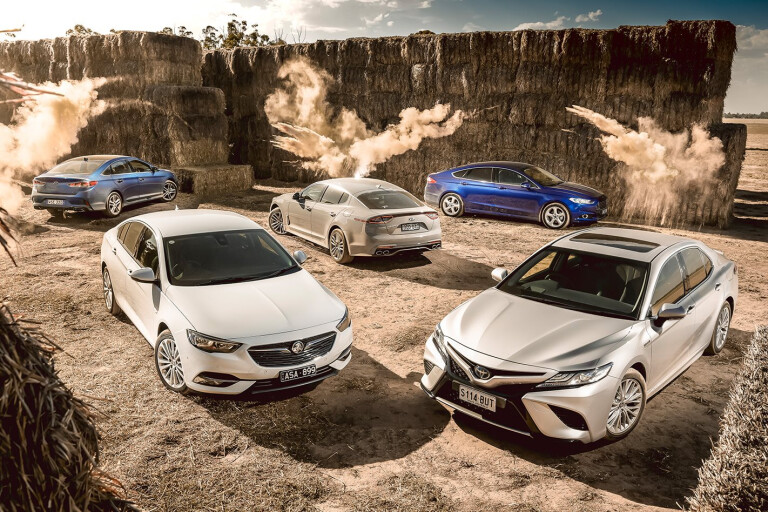
WE REALLY shouldn’t take it personally. Sliding sales of medium to large cars may have pulled the manufacturing rug out from under the Aussie-made Mitsubishi 380, Ford Falcon, Toyota Camry and Holden Commodore over the last decade, but it’s a global phenomenon affecting every developed market in the world.
Facing a juggernaut of SUV aspiration, car sales are faltering – especially mainstream medium types – in a dramatic fashion. Ford sold 56,172 Mondeos across Europe last year, supported by more than 200,000 sales of the identical Fusion in the US, yet even that combined total isn’t a patch on its 322,716 European sales from 20 years earlier. Or enough to prevent the Blue Oval from gradually phasing out much of its passenger-car line, in lieu of expansion with EVs, SUVs, and trucks.
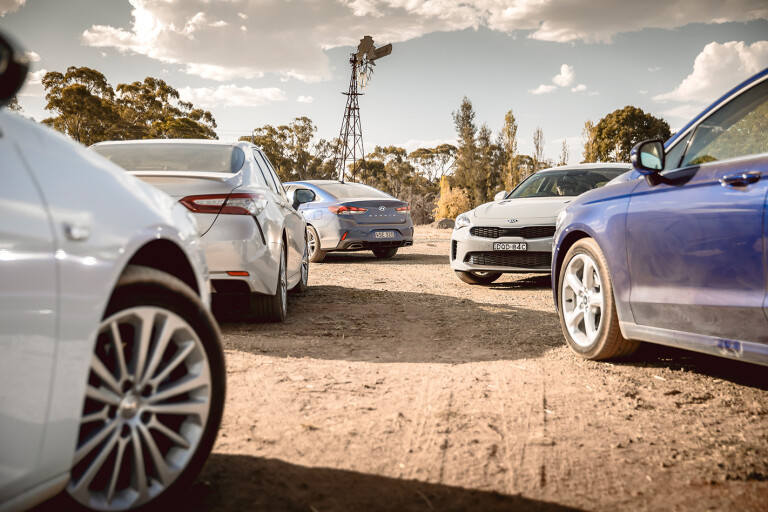
The new-gen Opel/Vauxhall Insignia (nee Holden ZB Commodore/Calais) snagged 72,347 sales in Europe last year – slightly less than the old model a year earlier, and a world away from the 384,885 Vectras flogged by GM in 1997 – while Toyota’s impressive new-generation Camry was beaten by the RAV4 in the US for the first time in 2017, which cracked 407,594 sales.
Hyundai’s once-strong Sonata is suffering a similar fate in the face of booming Tucson and Santa Fe popularity, while even Kia’s striking, left-field Stinger is yet to make the impact its passionate design team were quietly hoping for. Six months in, just over 6000 have been sold in the US, while its Australian tally sits at 1185, or just over half its European total. That’s chicken feed in mainstream circles.
It’s entirely possible, then, that the mid-size crew of the future will become the new niche – one that mixes the agility, weight, and efficiency advantages of a proper car with newfound sparkle and style (think Peugeot’s imminent frameless-doored 508 coupe-sedan). But where does that leave the current crop? Trading on former glories or deserving of a rosier future?
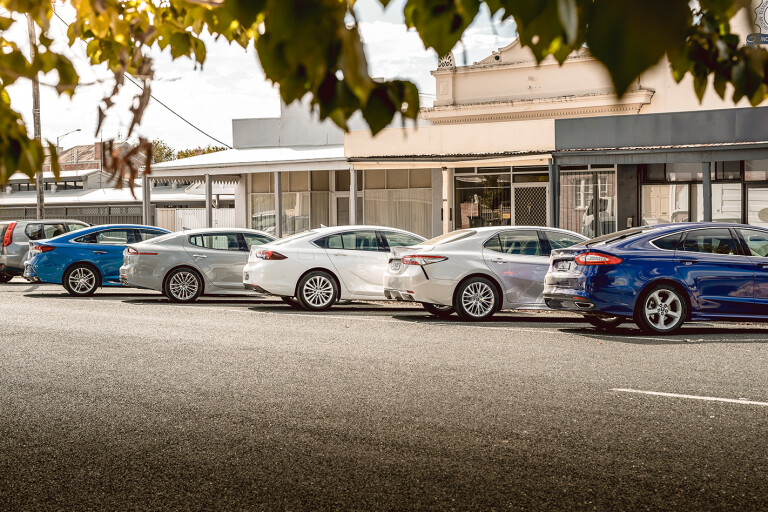
You know there’s something in the water when even Toyota pulls out all stops creating its next Camry generation. Model cycle eight inherits Toyota’s promising new TNGA platform and brings with it a level of Lexus-style craftsmanship and refinement that has been alien to Camry for at least 20 years. Lowest-common-denominator engineering is out; benchmark-challenging ability is in, even though the gen-eight Camry was designed and engineered for Americans.
Miraculously, it feels high-end Japanese and that’s an achievement. Especially our $40,990 SL Hybrid test car, with its ventilated perforated-leather seats, organically formed soft-touch dashboard, and even the intriguing depth of its multi-hued Steel Blonde paint colour. In some lights, it could be mushroom. In others, almost mauve.
That may sound about as hip as denture repair but it really enhances the Camry’s handsome shape. For once, a multitude of creases and swage lines genuinely contribute to the greater good, styling-wise, though that doesn’t apply to Camry’s mouthguard-like grille insert, or its bizarre Alice Cooper-esque rear bumper slits.
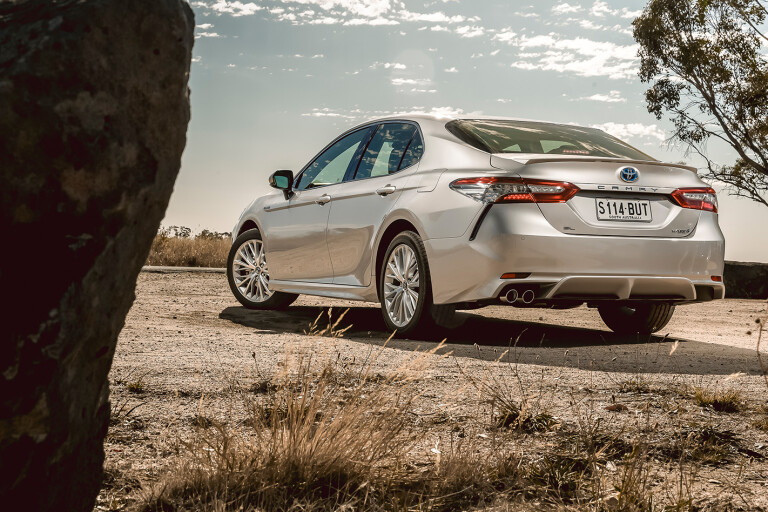
The identically priced Holden Calais, in comparison, feels deeply Germanic. Unlike the almost sumptuous Camry SL, the Calais nameplate is no longer reflective of a plush, cosseting trim level. Instead, we’re talking soberly monochromatic colours, firmly padded charcoal leather seats, minimal embellishment and a relatively austere feel. This is Calais motoring 2018-style, with nary a hint of stripy velour or chromy sparkle, though what you lose in visual glitz you definitely gain in engineering depth. There’s a stallion hiding beneath the Calais’ dowdy dress sense.
At a razor-sharp $37,790, the Ford Mondeo Trend is almost the Calais you have when you aren’t having a Calais. Its leather-edged sports seats with tactile microfibre centres allow you to sink into them (unlike the all-leather chairs in the $44,790 Titanium) while from the outside, you’d never know this 18-inch-wheeled Trend costs more than three grand less than the Holden.
Stretch to Titanium spec and you cop a faceful of visual va-va-voom (sequential indicators, LED headlights, bad-arse 19s, all-glass roof, the lot), but it’s the Mondeo Trend that best aligns with Calais. Even Mondeo’s circa-2012 fastback shape was clearly the inspiration for Opel’s take on the same style.
Hyundai’s facelifted Sonata can’t compete with the level of choice offered by Toyota, Holden and Ford, or even its distantly related Kia Stinger cousin. Just two variants remain on the grid in 2018 – base $30,990 Active and loaded $45,490 Premium, running the same 2.0-litre turbo-petrol four and eight-speed automatic as the $46,990 Stinger 200S – which means if you want a Sonata with grunt, it’s Premium or nothing.
Hyundai has left almost nothing untouched in its quest for garnering the Sonata some attention, at least visually. The Korean brand’s Californian styling studio went wild in transforming the old model’s quietly handsome shape into something that looks virtually unrelated, and the result is questionable.

The facelifted Sonata’s combination of pinched grille, fussy details, and flat-panelled rear, with italicised bootlid lettering, don’t add up to the kind of sophisticated touches we’ve come to expect from one of the world’s burgeoning automotive superpowers. Weirdly, it looks smaller than before, and lacks the on-road presence of its predecessor.
A similar tale applies inside. Unlike the previous-gen Sonata (badged i45 in Australia), which blended quite a radical exterior with a similarly rakish interior, the current car’s geometrically simple dashboard – in itself no major crime – now simply looks chintzy. It’s the equivalent of adding extra ingredients to a recipe in order to fix it, at which point you realise it’s beyond the point of no return.
There’s bucketloads of equipment inside the Sonata Premium: full glass roof with opening sunroof, heated and cooled front seats with two-position memory for the driver, rear door blinds, wireless phone charging. But the mis-matching materials, faux Paul Smith striped trim inserts, excess of plasti-chrome and curious utility/ergonomic flaws (why do the doors only take 600ml bottles? And why does the flat rear seat squander all that legroom?) convey expedience rather than expense.
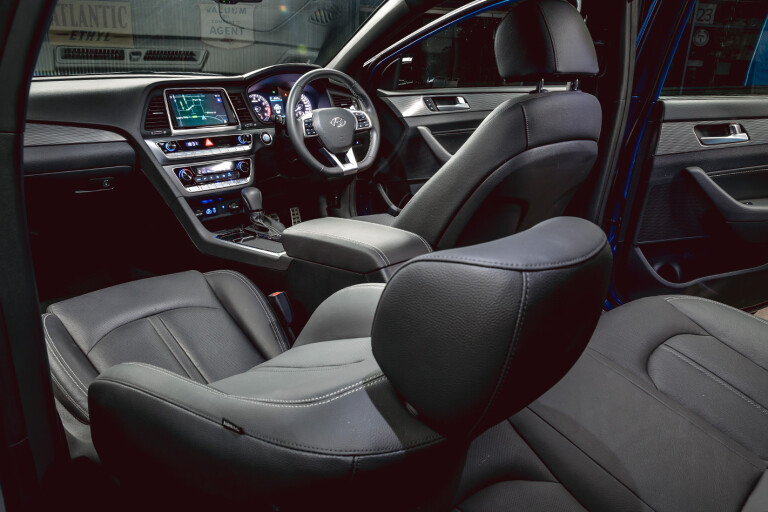
Contrast all that with Kia’s holistically designed Stinger. It’s this group’s wildcard in that it’s a rear-wheel drive liftback-sedan, supposedly competing in a larger car category. Yet if you read the fine print, the Stinger is actually the shortest and lowest car here, riding on by far the longest wheelbase. It’s all about proportion – that crucial determining factor the Sonata so desperately lacks – and the Stinger exudes copious amounts of it.
We wanted a base $46,990 Stinger 200S (now with standard AEB and collision warning) for this test but could only get our hands on a $53K 200Si. So if you can imagine the same Stinger without front parking sensors or lane-keep assist, adaptive cruise, auto wipers, a luggage net, a pair of subwoofers, and with a smaller touchscreen and non-leather trim, then here’s your 200S – still the dearest car here but arguably the richest.
You can tell that the team responsible for the interior architecture were on the same page as the aesthetes who created the Stinger’s coke-bottle hips and broad, planted stance. Internally, it’s definitely a case of less is more, where simple, elegant design and flowing forms rule, yet the packaging of the Stinger neatly supports its GT-like form. It may not offer the room of the Sonata, but you’re stepping into a cosseting, comfortable four-seater, with its steering column much closer to hortizontal and your legs stretched out in front, sports-car style, not into a vast area that fails to truly welcome you.
With four bodies on board, that’s exactly how the Stinger behaves. Even riding on relatively modest 225/45R18s, it feels taut when driving on your own, to the point where you always know what’s going on underneath, but when punished on challenging turf, you can keep adding speed and the Stinger simply demolishes the road surface. It has an underlying pliancy and levelness to its suspension behaviour that, in conjunction with its handling immediacy and rear-drive purity, helps it transcend the medium-size class in which it so obviously competes.

The same used to apply to the loping, luxurious VF Calais, so it’s a hugely interesting exercise examining the differences between its former self and the front-drive turbo-petrol ZB version. For starters, the new Calais’ packaging is terrific, with loads of rear-seat legroom and an amphitheatre-style view in all directions, combined with vast amounts of front-seat height adjustment.
If you’re mega-tall (like some Germans), you can dump the Holden’s supportive front chairs on their runners – to the detriment of rear toe room – and still have headroom beneath its skimpy little sunroof. But the Calais’ sloping rear roofline does impede on rear headroom. If you demand vertical space, buy the more handsome and useful Commodore Sportwagon.
What can’t be discounted, though, is the Calais’ unbreakable ride. You can hammer over rough surfaces and it refuses to be shaken, even though it isn’t as quiet as the Camry in doing so, and there’s a bombproof feel to the ZB that makes spending many hours bonding with its superb driving position utterly effortless.
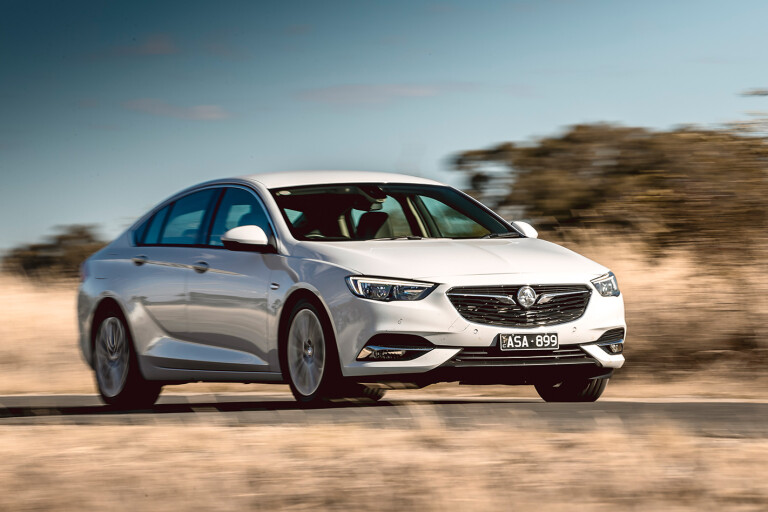
The flipside of this bombproof nature, however, is that the Holden is also furnished a little like a bomb shelter. It’s a Calais in name only. In lieu of the nameplate’s former plushness, warmth and texture, the new car feels German-style fleet hack, with a distinct Aldi flavour. Its seemingly hard-wearing interior should do a decent job of rolling with life’s punches, yet it’s about as colourful as a coal mine. Unlike the Stinger and new Camry – not to mention a three-year-old Volkswagen Passat – the ZB Calais isn’t the flavoursome premium alternative it needed to be.
Neither is the Mondeo, though at least it has age in its defence. Daggy home hi-fi silver console trim and the lack of a digital speedo expose the Ford’s 2012 vintage, yet there’s an inherent rightness – and suppleness – to the Mondeo that keeps it at the pointy end for driving panache. In fact, its overly familiar shape and dated dashboard design completely undersell the finesse and depth of engineering that are in the chassis and drivetrain of this car, not to mention the overall quietness and ride comfort.
The Mondeo treads a fine middle ground between the controlled tautness of the Stinger and Calais, and the refined suppleness of the Camry, rounding off edges of bumps while maintaining excellent body control and handling poise, right up to the point where the Holden’s handling focus and steering precision ultimately nudge it ahead of the heavier, softer Ford.
But it’s the Camry that takes the lead for ride. While its rear seat leaves passengers sitting a little splay-legged, without the foot and toe room of the Ford and Holden, the softly-sprung Toyota is sweetly damped and glides along with a quiet, Lexus-like sheen. Even its windscreen wipers have a silky movement emblematic of the advance in this car’s dynamic qualities.
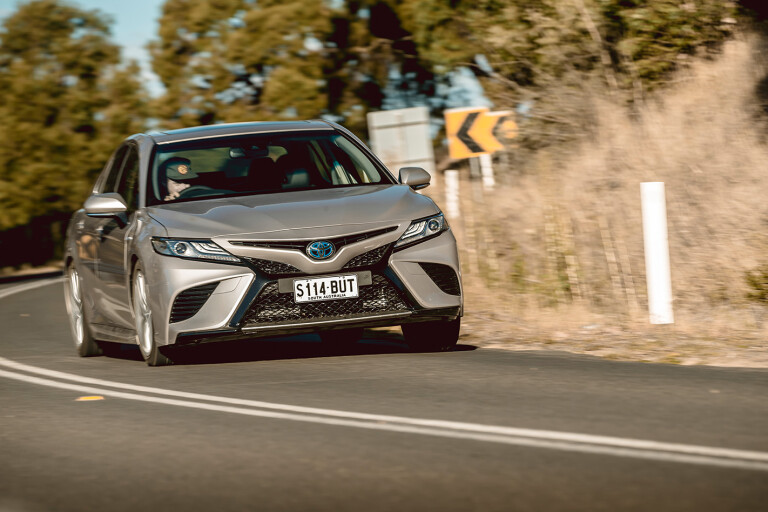
In combination with a re-engineered hybrid layout that combines an all-new Atkinson cycle direct-injection four with battery placement now below the rear seat rather than in the boot, the Camry has been transformed. It possesses a supple fluency, yet it responds beautifully to trail-braking into corners, involving its sophisticated double-wishbone rear end in proceedings while providing far more handling verve than anyone could expect. And its sweet drivetrain now gets an effective Sport mode, adding stepped gears for engine braking and even shift paddles on its lovely new wheel.
At 16-dead down the standing 400m and 80-120km/h in 5.3sec, the Camry might be the slowest of all the cars here but it never feels gutless. Its overall efficiency is outstanding, however, even without taking advantage of the benefits of its battery-only mode in city driving. Driven hard, the Camry averaged 7.5L/100km on test, smashing the Sonata and Stinger drivetrain cousins on 9.7 and 10.3L/100km respectively, not to mention the far thirstier Mondeo (11.3) and Calais (11.6L/100km).
The restyled Sonata demonstrates just how far Camry has come in its generational leap. The Aussie-tuned Hyundai has handling balance on its side, and the purchase of its pricey Michelins, but it feels like a patchwork of elements forced to cooperate. Its front seats don’t quite go low enough, yet there’s a lack of toe room underneath them, and anyone seated in the rear will feel lateral shifting, vertical movement and suspension drumming on rough roads. Its steering will also occasionally snatch at the driver’s hands when pushing through lumpy corners, though compared to where it once was, Sonata has come a long way.
But not far enough. Not after driving the Stinger, Mondeo or Calais. And despite its new eight-speed automatic, the test Sonata’s engine proved weirdly off-colour, posting significantly inferior performance to the gutsy Stinger, though without any detriment to its sweet refinement. Indeed, the strength of the Kia’s acceleration (0-400m in 15-dead, and 80-120km/h in 4.6sec) ably supports the immediacy of its turn-in, the instant involvement of its rear suspension and the multi-layered talent of its handling. The steering’s slight numbness at dead straight-on and the engine’s rather vocal synthesised induction note are minor blemishes on a dynamic repertoire that extends far and wide.
Only the Calais can truly challenge the Stinger for handling. Beautifully crisp and accurate steering, a perfectly sized three-spoke wheel, and genuinely amusing handling lift the Holden well beyond its underwhelming appearance. And then there’s its excellent 191kW/350Nm turbo-petrol four, which lags behind the AWD V6 version by just 0.3sec to 100km/h (6.5sec) and can nail a 14.7sec standing quarter. In rolling acceleration, the Calais belts the rest of this group. In fact, it’s strong enough to challenge any hot hatch near its price point.
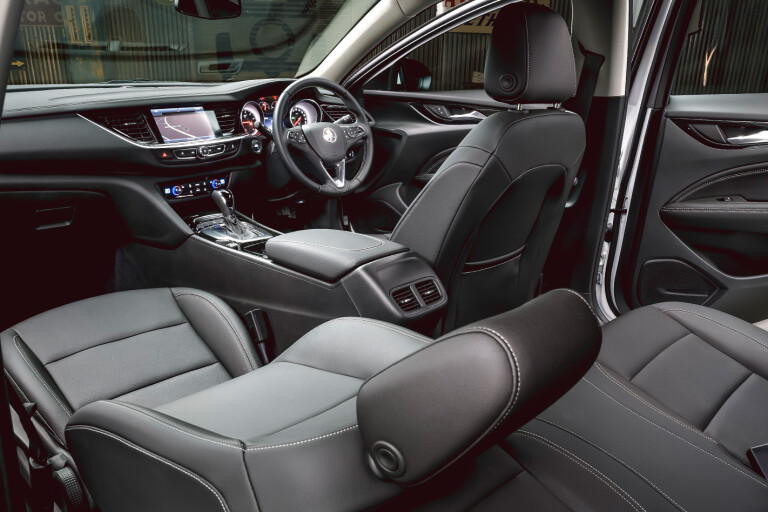
If only GM’s nine-speed automatic would hold onto gears with some level of sport-mode logic (it’s a one-setting-fits-all ’box). Perhaps our attempts at trying to provoke it to do so might explain some of its thirst for fuel, though we can’t understand why a car as quick and as sporting as this lacks steering-wheel paddles.
At the outer limit, the ageing Mondeo cedes dynamic talent to the Calais, but approaching that point it remains an absolute delight. A Sport mode that genuinely works, a pair of cooperative wheel paddles, and a still-strong and spirited engine make the Mondeo arguably the sweetest dynamic compromise here the majority of the time. It may be old, but age is proving no barrier to its ability ... providing people can get over the fact that the Ford Mondeo is never going to be an SUV. It’s just a bloody good car.
Unfortunately, however, therein lies the problem. If the secret to salvation for the mid-size class is freshness, dynamism and flair, then a sedan like the Hyundai Sonata is flying dangerously close to extinction. Not only is the MY18 model a flawed example of how to facelift a car, it’s a below-average product in a shrinking market sector. And if that doesn’t scream ‘dead duck’, then its tanking US sales performance should be sending messages to Namyang in bold red capitals.
Exactly the opposite is true of its spiritual blood brother, the Kia Stinger. Developed at the same proving ground in South Korea, with a big dose of European aesthetic, Nurburgring dynamic flavour and good old instinct for good measure, the Stinger is the only car here that is truly ‘cool’.
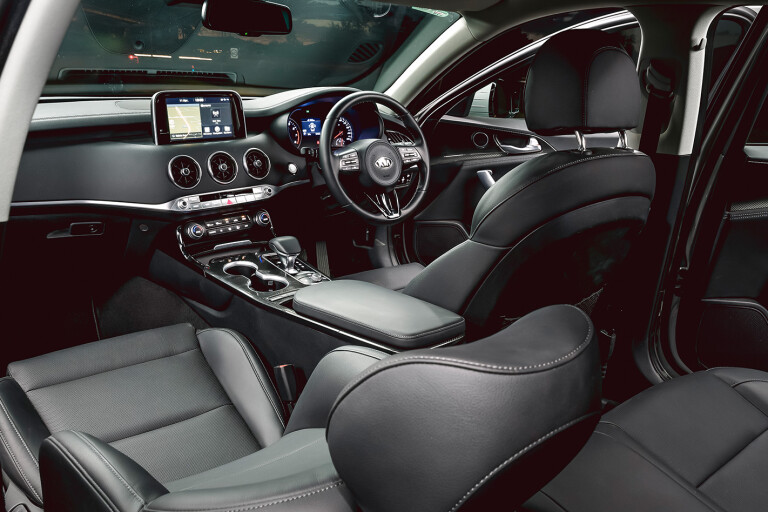
Even in base four-cylinder form, the Stinger is a super-sweet driver’s car that invigorates every journey, without forgetting about the practical aspects of seating four adults and packing a vast liftback tail for their luggage. It’s only a decent set of rims away from looking like $60-80K worth, and there’s a boutique-ness to it that makes it feel the most expensive car here. Yet there’s also real value in this unashamedly anti-SUV, gran-turismo-esque, coupe-liftback-sedan concoction.
The new-gen Camry approaches a similar level of ‘special’ from a different perspective. On paper, it’s just another front-drive Toyota with a familiar (albeit extensively modified) hybrid drivetrain and an efficiency bent. But what efficiency! Beautifully built and impressively refined, it does everything Toyota buyers want, yet has finally discovered sophistication, luxury and nuance. You could even go as far as saying it’s the best American car currently sold in Australia.
Which leaves the European Ford and Holden fighting it out for the middle ground. Despite their difference in age, they’re surprisingly similar in ability – especially their outstanding braking performance, as you’d expect from two cars designed to spend many hours plying German autobahns. Yet the Mondeo actually wins out in terms of refinement, mechanical sweetness and all-round finesse.
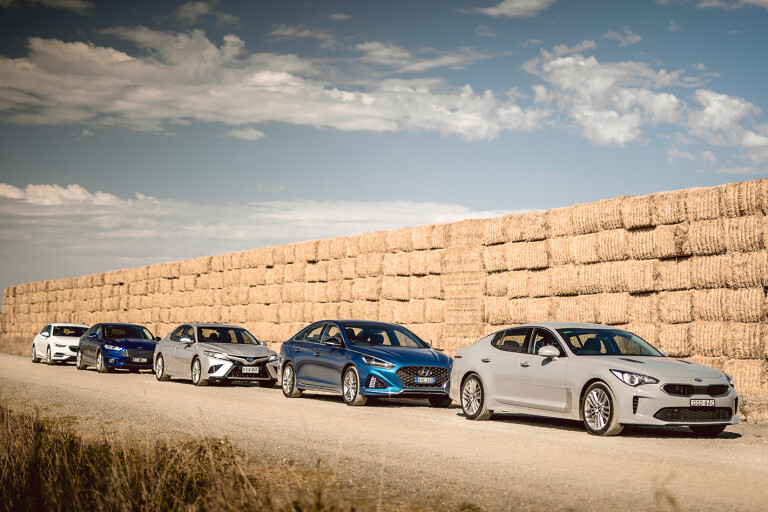
Confident and capable as the Calais is, it doesn’t join all the dots together quite as effectively as its Kia, Toyota and Ford rivals. In fact, the only areas where the Calais beats the Mondeo is for acceleration, 10-tenths handling, overall cabin space and its number of gear ratios. Otherwise, it’s just another German company car – very good at what it does, but also rather charmless in some ways, aside from the dynamic flavour imbued in it by Holden’s chassis engineers.
Going forward, that may not be enough to save the medium-car category. For now, though, if you’re averse to joining the SUV brigade, some fine alternatives await.
COMMENTS